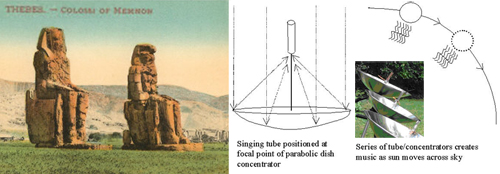A thank you to Dr. Michael Duffey (Associate Professor in the School of Engineering and Applied Science at George Washington University) for sharing with us his amazing solar thermal music devices. A series of these devices create a sort of solar pipe organ with beautiful effect. You can see some videos of some prototype designs in action here and here.
What is equally amazing is the long history behind such devices which have their origin in one of the Colossi of Memnon at Thebes, near present day Luxor, Egypt. The two statues depict Amenhotep III from 14th century BCE. In 27 BCE, an earthquake crumbled the top of one of them. The way that the stone collapsed must have created a pocket in which water would collect from nighttime dew. During the early morning sun, this dew would steam and create a harmonic noise through a fissure in the rocks. The statues then were renamed (no one by then remembered Amenhotep of course) after the Greek “ruler of the dawn” Memnon, a hero from the Trojan War. The association with dawn is thought to have come from the singing of the stone in the early morning sunlight.
From Wikipedia:
The sound was most often reported in February or March, but this is probably more a reflection of the tourist season rather than any actual pattern. The description varied; Strabo said it sounded “like a blow”, Pausanias compared it to “the string of a lyre” breaking, but it also was described as the striking of brass or whistling. The earliest report in literature is that of the Greek historian and geographer Strabo, who claimed to have personally heard the sound during a visit in 20 BC, by which time it apparently was already well-known. Other ancient sources include Pliny (not from personal experience, but he collected other reports), Pausanias, and Juvenal. In addition, the base of the statue is inscribed with about 90 surviving inscriptions of contemporary tourists reporting whether they had heard the sound or not.
The legend of the “Vocal Memnon”, the luck that hearing it was reputed to bring, and the reputation of the statue’s oracular powers, travelled the length of the known world, and a constant stream of visitors, including several Roman Emperors, came to marvel at the statues. The last recorded reliable observation of the sound dates from 196 (AD or CE). Sometime later in the Roman era, the upper tiers of sandstone were added (the original remains of the top half have never been found); the date of this reconstruction is unknown, but local tradition has this circa 199, by Roman Emperor Septimius Severus in an attempt to curry favour with the oracle (it is known that he visited the statue but did not hear the sound).
The Colossus of Memnon is a beautiful thousands-year collaborative artwork between man and nature. And not only is it a beautiful sculpture, but it is a solar powered sound art installation as well. This powerful history has influenced a number of creative minds over the centuries since. While they don’t create energy outside of that which is used to create the sound, they may still be inspirational references to those who are interested in designing Land Art Generators.
Detailed background about the solar thermal music project with technical links and more information about the Memnon history can be found at Dr. Duffey’s website on the project which he warned us is a little out of date, but which we nevertheless found riveting.


